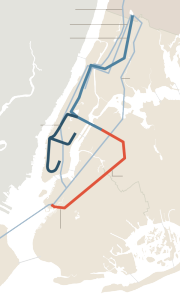Last week, The New York Times reported that Mayor de Blasio had postponed the expansion of the third water tunnel. This portion of the tunnel is meant to serve the growing population of Brooklyn and Queens.

PC: New York Times
After seeing water rates rise during the Bloomberg administration, some have alleged that de Blasio’s decided it was best to shift the funding from Tunnel 3 to other projects that would allow for more stabilized water rates. The urgency to build backup tunnels was sparked of during the 1950’s, with construction starting the the 1970’s and finally being completed in the mid 2010’s for Bronx and Manhattan, allowing for 10 shafts of a near century-old tunnel to be taken out of service for repairs.
What does this postponement mean? Should Tunnel 2 fail, Brooklyn and Queens would be unable to provide water to its some 5 million (and counting) residents. There have been $52 million allocated to scope and design the two shafts in Maspeth that are needed to complete the project – but money towards the actual construction has yet to be seen. Additional reasoning provided by Mr. Roberts, the deputy commissioner, that “Tunnel No. 2 was in better shape than Tunnel No. 1, reducing the urgency to complete No. 3 for Brooklyn and Queens.”
The completion of this project, already one of the world’s most complex engineering feats, would run over 60 miles, and be the largest in the United States. While it may accumulate more debt, or cause a rise in water rates, this is a necessary infrastructure project, as Adam Forman, a senior researcher at the Center for an Urban Future states, “Tunnel 3 is a high priority project” in regards to the balancing act occurring between the $7 million spent each day on infrastructure projects versus the debt that this tunnel expansion would cause.
As of Wednesday, April 6th, the Mayor has announced that he is allocating the necessary funding ($305 million) to begin construction of the tunnel by 2020, with reports that the contracts necessary for construction will be signed as of June, 2019. To further clarify, the mayor states “that money was put on hold for budgetary reasons – looking to ensure the accuracy of estimates. Instead, during the preliminary budget, they began adding money back at very specific amounts, allowing to keep things on track for Bloomberg’s 2021 schedule”. The administration also wanted to state that in their findings, under Bloomberg’s plan construction would begin (not end) in 2021 – a timetable that did not stray far from the discrepancy announced of mid 2020’s on Monday.
While the concern of raising water-rates in on the table, it is imperative to note that the impact of the construction will not cause that great of an increase – and is necessary to complete the project and ensure that Brooklyn & Queens maintain their water supply – and allow for the repairs to the aging water tunnel – something that has been of concern for nearly 50 years.
